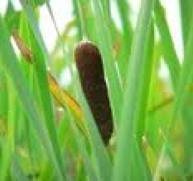Rush
The true Rushes (Juncaceoe) include the Soft Rush (effusus); the Hard Rush (glaucus); and the Common Rush (conglomeratus). The Bulrush (Pool Rush) is a Sedge; the Club Rush is a Typha; and the flowering Rush, a Butomus.
Added Dec 1, 2010
| 6,271 Reads
"Rish" was the old method of spelling the name. A medicinal tincture is made (H.) from the fresh root of the juncus effusus. It will be found helpful against spinal irritability, with some crampy tightness felt in the arms and legs, together with headache and flatulent indigestion. Four or five drops should be given for a dose, with a spoonful of water, three or four times in the day. This, the Soft Rush, is commonly used for tying the bines of hops to the poles; and, as these bines grow larger in size, the rushes wither, setting the bines free in a timely fashion. To find a green-topped Seave, or Rush, and a four-leaved Clover, is, in rural estimation, equally lucky. The generic title, Juncus, has been applied because Rushes are in conjunction when planted together for making cordage. The common Rush is found by roadsides in damp pastures, and is readily known by its long, slender, round, naked stem, containing pith, and showing about the middle of July a dense globular bead of brown flowers. Rushes of this sort were employed by our remote ancestors for strewing, when fresh and green, about the floor of the hall after discontinuing its big fire at Eastertide. Shakespeare says in Romeo and Juliet:-- "Wantons, light of heart, Tickle the senseless rushes with their heels." In obedience to a bequest (1494); Rushes are still strewn about the pavement of Redcliff Church at Bristol every Whit-Sunday. The common phrase, "not worth a Rush," took its origin from this general practice. Distinguished guests were honoured in mediaeval times with clean fresh Rushes; but those of inferior rank had either the Rushes left by their superiors, or none at all. The sweet-scented "Flag," or Rush (Acorus calamus), was always used by preference where it could be procured. It is a native of this country, growing on watery banks, and very plentiful in the river's of Norfolk, from whence the London market is supplied. The roots have a warm, bitter taste, and the essential oil is highly aromatic, this being used for preparing aromatic vinegar. In Norfolk the powdered dry rhizome is given for ague. With sugar it makes an agreeable cordial conserve. (See Flag (Sweet), page 201 ). For preserving the aromatic qualities within the dried rhizome; or root, it should be kept in stock unpeeled. This contains "oleum calami," and the bitter principle "acorin." Some of the root may be habitually chewed for the relief of chronic indigestion. The odorous delights of a pastoral time passed near these sweetly-fragrant plants have been happily alluded to in the well-known lines of idyllic verse:-- "Green grow the Rushes, oh! Green grow the Rushes, oh! The sweetest hours that e'er I spent Were spent among the lasses, oh!" "Virent junci fluviales, Junci prope lymphas: Ah! quain ridet quoe me videt Hora inter Nymphas!" The old saying, "As fit as Tib's Rush for Tom's fore-finger," alludes to an ancient custom of making spurious marriages with a ring constructed from a Rush. Tom and Tib were vulgar epithets applied in Shakespeare's time to the rogue, and the wanton. The Bulrush (Scirpus lacustris) is a tall, aquatic plant, which belongs to the Sedge tribe. It name was formerly spelt "Pole Rush," and was given because this grows in pools of water, and not like other Rushes, in mire. Bottoms of chairs are frequently made with its stems. Its seed is prepared medicinally, being astringent and somewhat sedative; "So soporiferous," says Gerard, "that care must be had in the administration thereof, lest in provoking sleep you induce a drowsiness, or dead sleep." Street hawkers, in Autumn, offer as Bulrushes the tall, round spikes of the Great Reed Mace, which is not a true Rush. Artists are responsible in the first instance for the mistake--notably Paul De la Roche, in his famous picture of "The Finding of Moses." The future great leader of the Israelites is there depicted in an ark amid a forest of Great Cat's-tail Reeds. The flowering Rush, or water gladiole, which grows by the banks of rivers is called botanically "butomus," from the Greek, bous, an ox, and temno, to cut, because the sharp edges of the erect three-cornered leaf-blades wound the cattle which come in contact with them, or try to eat them. Its root is highly esteemed in Russia for the cure of hydrophobia, being regarded by the doctors as a specific for that disease. Its flowers are large, and of a splendid rose colour. The seeds promote the monthly flow in women, act on disordered kidneys, prove astringent against fluxes, and serve to woo sleep in nervous wakefulness. Gerard tells that "the seed of Rushes drieth the overmuch flowing of women's termes." The Reed Mace, or Cat's-tail, is often incorrectly called Bulrush, though it is a typha (tuphos, marsh) plant. The Bog Asphodel (Narthecium ossifragum) grows in bogs, and bears a spike of yellow, star-like flowers. Its second nominative was given to signify its causing the bones of cattle which feed thereon to become soft; but probably this morbid state is incurred rather through the exhalations arising from the bogs where the cattle are pastured. To the same plant has been given also the name "Mayden heere," because young damsels formerly used it for making their hair yellow. The Great Cat's-tail (Typha palustris), or Great Reed Mace, a perennial reed common in Great Britain, affords by the tender white part of its stalks when peeled near the root, a crisp, cooling, pleasant article of food. This is eaten raw with avidity by the Cossacks. Aristophanes makes mention of the Mace in his comedy of frogs who were glad to have spent their day skipping about inter Cyperum et Phleum, among Galingale and Cat's-tail. Sacred pictures which represent our Saviour wearing the crown of thorns, place this reed in His hands as given Him in mockery for a kingly Mace. The same Typha has been further called "Dunse-down," from making persons "dunch," or deaf, if its soft spikes accidentally run into the ears. "Ejus enim paniculoe flos si aures intraverit, exsurdat." It is reasonable to suppose that, on the principle of similars, a preparation of this plant, if applied topically within the ear, as well as taken medicinally, will be curative of a like deafness. Most probably the injury to the hearing caused by the spikes at first is toxic as well as of the nature of an injury. The Poet Laureate sings of "Sleepy breath made sweet with Galingale" (Cyperus longus). Other names again are, "Chimney-sweeper's brush"; "Blackheads" until ripe, then "Whiteheads"; and "Water torch," because its panicles, if soaked in oil, will burn like a torch.
Added Dec 1, 2010
| 6,271 Reads
Share The Magic ...
The GoE MONEY!!! Course - A Course In Real MONEY MAGIC!
|





















